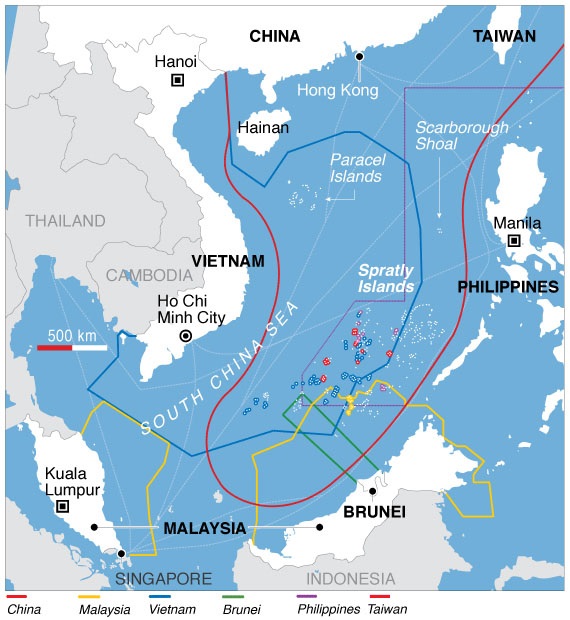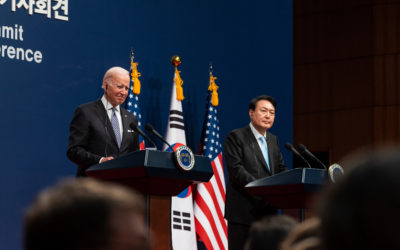On April 26, U.S. President Joe Biden welcomed South Korean President Yoon Suk-yeol to the White House for a summit meeting to celebrate the seventieth anniversary of the U.S.-South Korea alliance and open a new chapter for the next seventy years of expanded cooperation. Amid a substantial list of topics discussed by the two leaders, extended deterrence emerged as the top deliverable.
The U.S. is about to blow up a fake warship in the South China Sea—but naval rivalry with Beijing is very real and growing
The U.S. is about to blow up a fake warship in the South China Sea—but naval rivalry with Beijing is very real and growing
The U.S. is about to blow up a fake warship in the South China Sea—but naval rivalry with Beijing is very real and growing
As part of a joint military exercise with the Philippines, the U.S. Navy is slated to sink a mock warship on April 26, 2023, in the South China Sea.
The live-fire drill is not a response to increased tensions with China over Taiwan, both the U.S. and the Philippines have stressed. But, either way, Beijing isn’t happy – responding by holding its own staged military event involving actual warships and fighter jets deployed around Taiwan, a self-governed island that Beijing claims as its own.
The tit-for-tat war games underscore a reality that U.S. presidents have increasingly had to contend with as the 21st century has drawn on. More than a century after President Theodore Roosevelt made the United States the preeminent maritime power in the Pacific, that position is under threat. China is seeking to displace it.
As a scholar of East Asian security and maritime disputes, I believe that the growing rivalry between the U.S. and China over dominance of the Pacific has the potential to define geopolitics in the Indo-Pacific region for the next half-century.
Already, ongoing maritime disputes pit China against several Asian countries. For example, China regularly challenges the maritime rights of Vietnam, the Philippines and Malaysia in the South China Sea and Japan in the East China Sea.
But the disputed waters are also of huge strategic importance to the U.S. It is where China is flexing its growing military might in the face of U.S. allies and partners, notably Taiwan, which the U.S. has committed to defend. If a war between China and the U.S. is going to happen, I believe the South China Sea is likely to be a major theater, with Chinese aggression toward Taiwan the spark.
The scramble over the South China Sea
For centuries, the dozens of islands, shoals, reefs, banks and rocks in the South China Sea were regarded as little more than hazards to navigation.
But with the discovery of large reserves of oil and gas in the 1970s and billions of dollars’ worth of fisheries, the previously largely ignored sea has gained significant attention from the countries whose shorelines meet it.
It led to a revival of elapsed conflicting claims of “ownership” over the sea.
China currently claims legal rights to the vast majority of the South China Sea, extending well beyond the boundaries established by the 1982 U.N. Convention on the Law of the Sea (UNCLOS).
This claim by China, designated on maps by a nine-dash line, overlaps with the legally recognized maritime and territorial rights of the Philippines, Vietnam, Malaysia, Brunei and Indonesia.

Voice of America, Public domain, via Wikimedia Commons
Over the past decade, China has consistently engaged in low-level coercive activities called “gray zone tactics,” such as small-scale deployment of the Chinese Coast Guard in disputed waters and the manning of fishing vessels with civilians trained by the Chinese military. The purpose is to harass others and assert Chinese maritime rights outside legal Chinese waters, as recognized under UNCLOS.
Since 2013, China has also built up several reefs and shoals into artificial islands, building military bases with runways, radar technology and missile-launching capabilities.
In 2016, an UNCLOS Annex VII arbitration panel ruled that China’s nine-dash line claims were illegal and rejected China’s rights to maritime features in the legal waters of the Philippines.
But despite the legally binding nature of the ruling, China has continued to militarize its artificially built-up islands and harass neighboring countries’ military and fishing vessels. It has also denied passage to U.S. Navy ships legally sailing through waters in the South China Sea.
Successive U.S. administrations have aired concern over developments in the sea. In 2020, then-Secretary of State Mike Pompeo issued a U.S. position on the South China Sea, rejecting China’s maritime claims and its “bullying” tactics as “unlawful.” His successor, Antony Blinken, in 2021 declared: “Nowhere is the rules-based maritime order under greater threat than in the South China Sea.”
But why does the South China Sea matter so much to the U.S.? The answer lies in economics and power politics.
A source of trade, natural resources
About one-third of the world’s shipping transits the South China Sea. In all, more than US$3.4 trillion worth of products – everything from rubber ducks to cars – is transported through its waters every year.
The sea connects the Pacific Ocean to the Indian Ocean, allowing trade from East Asian countries to flow to and from billions of people in South Asia, the Middle East, Africa and Europe. It is also where 14% of all U.S. maritime trade passes through. It is a crucial route for outgoing U.S. goods as well as getting products to the U.S. Without it, the transport of products we use every day would slow down, and these products would cost more.
And then there are oil and gas. Around 30% of all global crude oil transits through the South China Sea. Furthermore, there is an estimated $11 billion worth of oil and 190 trillion cubic feet of proven deposits of natural gas in the sea, as well as undiscovered oil and gas.
Meanwhile, more than half of all fishing vessels in the world operate in the South China Sea.
For economic reasons alone, the U.S. and the rest of the world need open trade routes and sea lanes in the South China Sea. Preventing one country – especially a hostile China – from controlling these trade routes and resources is a crucial policy concern for Washington.
Power politics at sea
Although economics plays a part, China’s actions in the South China Sea are part of a much broader aggressive campaign. Beijing views territorial and maritime control in the region through the lens of its national security. It seeks to project its power in the region and defend the Chinese mainland.
Ultimately, as acknowledged by the U.S. government, China is looking to overturn the status quo, replacing the U.S. as the superpower.
This battle for power is already taking shape in the South China Sea, with regular confrontations between U.S. naval vessels and China’s maritime militia and navy.
The artificial islands in the South China Sea provide China with military capabilities far beyond the mainland alone. These outposts can be used to help counter and fight the U.S. and its allies, for example, in a war over Taiwan.
While the U.S. is not itself a claimant in the South China Sea disputes, the waters there remain a significant priority for the national security interests of Washington, too.
It is why the U.S. and its allies conduct freedom of navigation missions through the South China Sea and engage in naval exercises such as the one taking place in April 2023 with the Philippines.
With China playing by a different set of rules than the U.S. and its allies in the region, the risk of clashes at sea is very real. It could even lead to conflict between the two most powerful countries in the world today.
The next time a warship is blown up in the South China Sea, I fear that it may not be just a drill.
This article was republished from The Conversation under a Creative Commons license to point warfighters and national security professionals to reputable and relevant war studies literature. Read the original article.

Dr. Krista Wiegand is Professor of Political Science and the Director of the Global Security program at the Center and oversees programing, workshops, speakers, and research projects with faculty fellows, a post-doctoral fellow, graduate student research fellows, and undergraduate student research assistants. She joined the UTK faculty in 2014 after nine years on the faculty at Georgia Southern University, and she received her PhD in Political Science from Duke University in 2004. Dr. Wiegand also serves as the co-Editor-in-Chief with Dr. Brandon Prins of International Studies Quarterly, the flagship journal of the International Studies Association.
Dr. Wiegand’s research covers territorial and maritime disputes, conflict resolution/management, war and militarized interstate disputes, terrorism and political violence, bargaining strategies, international mediation, arbitration, and adjudication of interstate and civil conflicts, and foreign policy strategies of states in East Asia.
She has published two books: Bombs and Bullets: Governance by Islamic Terrorist and Guerrilla Groups (Routledge, 2010) and Enduring Territorial Disputes: Strategies of Bargaining, Coercive Diplomacy, and Settlement (University of Georgia Press, 2011), and is co-editor of the book Islands of Contention: The China-Japan Border Dispute in a Multidisciplinary Perspective (Routledge, 2015). She has a forthcoming book co-authored with Dr. Emilia Justyna Powell, Notre Dame University, The Peaceful Resolution of Territorial and Maritime Disputes (Oxford University Press, 2023).
Related Articles
President Marcos Jr. Meets With President Biden—But the U.S. Position in Southeast Asia is Increasingly Shaky
Over a four-day visit to Washington, Philippine President Ferdinand Marcos Jr. has been welcomed to the White House and generally feted across Washington. With President Biden, Marcos Jr. (whose father was forced out of office in part through U.S. pressure, and whose family has little love for the United States) affirmed that the two countries are facing new challenges, and Biden said that “I couldn’t think of a better partner to have than [Marcos Jr.].”
Why the Philippines Is Exposing China’s Aggressive Actions in the South China Sea
Over the past few months, the Philippine Coast Guard (PCG) has expanded its responsibilities beyond its usual task of patrolling the West Philippine Sea, the portion of the South China Sea claimed by Manila. The PCG has now taken on the role of exposing the unlawful activities of both the China Coast Guard (CCG) and alleged Chinese Maritime Militia (CMM). This new responsibility came about following an incident in February, where the CCG used a military-grade laser against a 44-meter PCG vessel that was supporting the resupply mission of the Armed Forces of the Philippines (AFP).



